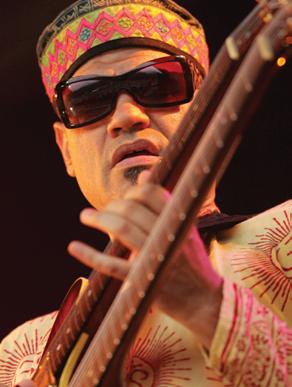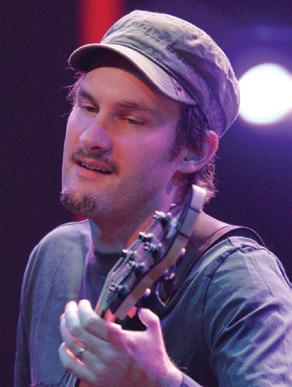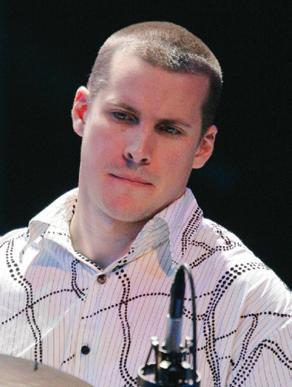24.2.2008
香港大會堂音樂廳
Concert Hall
Hong Kong City Hall
演出長約1小時30分鐘,不設中場休息
Running time: approximately 1 hour and 30 minutes with no interval
Feature: The Red Fire of Hiromi
為了讓大家對這次演出留下美好的印象,請切記在節目開始前關掉手錶、 無綫電話及傳呼機的響鬧裝置。會場內請勿擅自攝影、錄音或錄影,亦不 可飲食和吸煙,多謝合作。
To make this performance a pleasant experience for the artists and other members of the audience, PLEASE switch off your alarm watches, MOBILE PHONES and PAGERS. Eating and drinking, unauthorised photography and audio or video recording are forbidden in the auditorium. Thank you for your co-operation.
Hiromi’s Sonicbloom
鋼琴及鍵琴 Piano and Keyboards 上原廣美 Hiromi
有品及無品結他 Fretted and Fretless Guitar
大衛.菲辛尼斯基 David Fiuczynski
低音結他 Bass
東尼.格雷 Tony Grey
鼓手 Drums
馬田.瓦利霍拉 Martin Valihora
加料節目 Festival Plus
演後藝人談
24.2.2008 (星期日夜場) 歡迎觀眾演出後留步,與上原廣美會面。
Meet-the-Artist (Post-Performance)
24.2.2008 (Sunday Evening)
If you would like to meet Hiromi, please stay behind in the auditorium after the performance.
本節目樂器及音響器材由通利琴行贊助 The musical instruments and audio equipment are sponsored by
上原廣美作曲
All music composed by Hiromi
時差
Time Difference
時間暫停
Time Out
時光旅行
Time Travel
夜深沉
Deep into the Night
真實時鐘 vs 生理時鐘 = 時差
Real Clock vs Body Clock = Jet Lag
時間和空間
Time and Space
掌控時光,或受時光掌控
Time Control, or Controlled by Time
時光飛逝
Time Flies
夠鐘
Time’s Up
演奏曲目及次序或有改動
Songs and their order of performance are subject to change
Hiromi 上原廣美
© Frank Capri
2003 年,上原廣美憑首張個人爵士樂 專輯《 AnotherMind 》,成名美國爵士 界。這股旋風更一路颳回家鄉日本,並 達金唱片銷量(十萬張),獲日本唱片業 協會頒發年度爵士唱片獎。
上原廣美1979年生於日本靜岡縣,六歲 開始學習鋼琴。她得到啓蒙老師教導, 不僅掌握了各種音樂技巧,也練就了對 音樂的敏銳直覺。她習琴不到一年,便 報讀山葉音樂學校。 12 歲開始登台演 出,經常與頂尖級樂團同台獻技。14歲 時,已赴捷克斯洛伐克與捷克愛樂樂團 合作。
其後,她的音樂趣味從古典音樂延伸到 爵士樂。17歲時與爵士鋼琴大師奇克. 柯瑞亞偶遇,次日便和大師同台演奏。
1999年上原赴美國波士頓伯克里音樂學 院學習。爵士樂低音結他宿將理查.伊 文斯是她伯克里音樂學院的導師,主教 編曲和配器法。伊文斯與他的老朋友、 老搭檔亞曼德.賈麥爾,聯合監製了上 原首張個人專輯《Another Mind》。
上原的第二張個人專輯《 Brain 》,連獲 多項大獎:包括 2004 年環廻立體聲地 平綫獎,日本權威爵士樂雜誌《搖擺日 誌》新秀獎,日本權威爵士樂雜誌《爵 士生活》金唱片獎,日本HMV最佳日本 爵士唱片,日本音樂筆友俱樂部日本藝 人獎。《Brain》還獲《搖擺日誌》讀者票 選為2005 年最佳唱片。
2006 年,上原摘下波士頓音樂獎最佳 爵士表演獎和健力士爵士音樂節新秀 獎,並獲《搖擺日誌》讀者票選為年度 爵士人物及鋼琴手,其唱片《 Spiral 》 則獲年度唱片。 2007 年,上原推出最 新專輯《掌控時光》,並與奇克.柯瑞 亞在東京藍調俱樂部演出鋼琴二重奏。
Hiromi first mesmerised the jazz community with her 2003 debut Another Mind. The buzz started by her first album spread all the way back to her native Japan, where Another Mind shipped gold (100,000 units) and received the Recording Industry Association of Japan’s (RIAJ) Jazz Album of the Year Award.
Born in Shizuoka, Japan, in 1979 Hiromi took her first piano lesson at age six. From her earliest teacher she learned to tap into the intuitive as well as the technical aspects of music. Taking that intuitive approach a step further, Hiromi enrolled in the Yamaha School of Music, less than a year after her first piano lessons. By age 12 she was performing in public, sometimes with very high-profile orchestras and when she was 14 she went to Czechoslovakia to play with the Czech Philharmonic.
Further into her teens her tastes expanded to include jazz, as well as classical music. A chance meeting with Chick Corea when she was 17 led to a performance with the well-known jazz pianist the very next day.
In 1999 Hiromi went to the US to study at the Berklee College of Music in Boston. Among her mentors at Berklee was veteran jazz bassist Richard Evans, who taught arranging and orchestration. Evans coproduced Another Mind, Hiromi’s debut album, with long-time friend and collaborator Ahmad Jamal.
Hiromi’s second release Brain won the 2004 Surround Music Award; Swing Journal’s New Star Award; Jazz Life’s Gold Album; HMV Japan’s Best Japanese Jazz Album; and the Japan Music Pen Club’s Japanese Artist Award. Brain was also named Album of the Year in Swing Journal’s 2005 Readers’ Poll.
In 2006 Hiromi won Best Jazz Act at the Boston Music Awards and the Guinness Jazz Festival’s Rising Star Award. She was also named Jazzman of the Year, Pianist of the Year and won Album of the Year in Swing Journal’s Readers’ Poll for her 2006 release Spiral. In 2007 she released her latest album Time Control and gave a piano duo concert with Chick Corea at Blue Note Tokyo.
The Red Fire of Hiromi
文:高永祥
顯而易見,上原廣美是個超級敏感的 鋼琴手,演奏時,周圍一切她都十分警 覺。一次演奏會中,有手機響起,她立 即以此鈴聲奏出和弦,既平息了騷擾, 又替冒失者解窘。不過,是什麼燃起她 的音樂激情,只有她才明白:「我看見 一大片火紅,真的。」28歲的上原, 演 奏素以快速瘋狂著稱,她笑着說:「我 就是這副性格,一旦全心投入,就會看 見那種色彩。」
離開鍵盤的上原和演奏時相反,看上去 很含蓄、隨意而快活。在她初上鋼琴課 的地方––東京目黑區山葉音樂基金 會,她一身綠衣裳,端坐在會客室的紅 色沙發上,細說這兒的音樂啟蒙老師, 如何用顏色來教她音樂:
by Yung-Hsiang Kao
It is easy to tell that Hiromi is a hypersensitive pianist aware of everything around her as she performs. During one concert a cell phone rang and she quickly played a chord based on the ring tone, smoothing over the interruption and lessening the embarrassment of the offender. What sparks her passionate musical style, however, is something only she can sense: “I definitely see a lot of fiery red, that’s for sure,” the 28-year-old, known for her fast-paced, nearly frantic playing, says with a laugh. “It’s just my personality. When I’m really going for it, then I see that type of colour.”
Contrary to the way she plays, Hiromi away from the keyboard seems reserved, relaxed and cheerful. She sits up straight in a green dress on a red sofa in
「她是位與眾不同的老師,總是用顏色 筆給樂譜着色。她從不用『強後即弱』、
『漸強』、『漸弱』等術語,只是給樂譜上 色。因此,當我看到紅色,就覺得有必 要彈得充滿激情。有時她寫下『憂鬱』 這樣的詞,還把它染成藍色,那我就彈 得憂鬱些。我覺得,對孩子來講,這種 做法非常好。因為你六七歲時,大腦不 能處理『強音』這樣的資訊,但是你看 得見顏色,理解顏色的含義。絞盡腦汁 去理解概念遠不及畫面直接。所以,我 確實能用情感來感受音樂。」
起初,上原學習古典鋼琴。八歲時,同 一位老師將她領進爵士樂的大門。儘管 她的專輯跨越多種樂風,從爵士樂、革 新爵士樂、融合音樂到古典樂、電子音 樂和搖滾樂,但她並不介意什麼稱號。 「我自己不會說我是什麼。」她說,「別 人可以將我歸類⋯⋯如果有人說我是爵士 樂手,那可以。如果有人說我是其他什 麼的,那也行⋯⋯我只想玩音樂,沒有 其他。」
同樣,也不能簡單地把上原歸類為日 本音樂家。她在東京山葉音樂學校修業 後,前往美國波士頓伯克里音樂學院, 以全額獎學金進修了四年,至今推出了 四張唱片,張張叫好,成為蜚聲國際的 音樂新星。去年,她奔赴各地及各音樂 節演出,如富士搖滾音樂節和紐約藍調 爵士俱樂部。 2007 年 9 月,上原在東 京藍調俱樂部,與傳奇爵士鋼琴大師奇 克.柯瑞亞同台演出。此次重逢,距兩 人初會已有11年。
儘管巡演緊張忙碌,上原每天仍堅持作 曲。「我不能保證每天都有創作,但我 會盡力而為。」她說,「這就像寫日記, 我一直盡力寫些觸動內心的東西。」上 原所有專輯的樂曲均親自創作。
上原首張專輯《AnotherMind》,以薩克 斯管和結他為主,配以鼓和低音結他。
a waiting room at the Yamaha Music Foundation in Meguro Ward, Tokyo, where she had her first piano lessons. She explains that her first teacher at Yamaha taught her music with colours:
“She was a very unique teacher. She always coloured my whole score with pencils. Instead of using musical jargon such as fortepiano, crescendo, decrescendo, she would just colour the score –– so that when I saw red, it made me feel like I needed to play with passion. And when she wrote some word like ‘melancholic’ and painted it blue, I had to play it blue. This is really good for, I think, kids, because your brain cannot really process what ‘forte’ is when you are six or seven, but you can see –– you can understand the colour, you can see visuals more than trying to understand something with the brain. So, I could really feel the music with my emotions.”
Hiromi first learned classical piano, but when she was eight the same teacher introduced her to jazz. Though her albums span a diverse range of genres –– from jazz, progressive jazz and fusion to classical, electronic music and rock ––she does not care for labels: “I don’t really name what I am –– myself,” she says. “(Other) people can label me… If they want to call me a jazz musician, then it’s OK; if they want me to be something else, that’s fine… I want to be music –– nothing else.”
In the same way, Hiromi cannot simply be classified as a Japanese musician. After studying at Yamaha, Hiromi took up a four-year full scholarship at the Berklee College of Music in Boston and released four acclaimed albums, becoming a world-renowned musical talent. Last year she performed at venues around the world as disparate as the Fuji Rock Festival and the original Blue Note jazz club in New York. In September 2007 she visited Blue Note Tokyo to play with the legendary jazz pianist Chick Corea, 11 years after their initial meeting.
隨後的兩張專輯,《Brain》和《Spiral》, 是為鋼琴、鼓和低音結他三重奏而作。
上原 2007 年的最新專輯《掌控時光》, 由她的四重奏班底廣美聲花樂隊演繹。
該專輯中,與上原聯手演奏的是革新爵 士搖滾結他手大衛.菲辛尼斯基,低音 結他手東尼.格雷和鼓手馬田.瓦利霍 拉,後兩人是上原伯克里音樂學院的校 友。
儘管上原帶領樂隊巡演各地,她並不確 定下一張專輯是否繼續以四重奏演出。
「我之所以組成四重奏樂隊,是因為覺 得之前的三人組已臻成熟,形成一個出 色的三重奏,非常穩定的三重奏。」說 時,她用雙手比畫一個三角形。「我一 直認為,如果事情到了非常穩定的地 步,就該打破。」
音樂須要冒險,須要保持振奮,這只是 上原點燃激情的部份燃料。在男性一統 天下的爵士樂壇,她的音樂成就、演奏 技巧和作曲天賦更讓人刮目相看。「你知 道,這並不輕鬆。我有打拚的理由。」
說這話時,她的臉微微漲紅。「要想真正 打拚,你得有愛和激情。有一道厚重的 牆––不是我造的––豎在那裏,因為 我是亞洲人,是女人,是樂手,我必須 每天和它搏鬥。」
高永祥 在紐約土生土長,現駐東京為《日本
時報》撰寫爵士樂文章。原文《上原廣美的琴 鍵「火紅」》,載於 2007 年 8 月 30 日之《日 本時報》。
Despite being busy with tours Hiromi still tries to compose every day: “I can’t create something every single day, but I try to,” she says. “It’s like keeping a diary. I always try to write something which caught my mind.” Indeed, Hiromi composes all the tracks for her albums.
Hiromi’s first album Another Mind featured saxophone and guitar along with drums and bass. Her next two albums Brain and Spiral were written for a trio of piano, drums and bass. Time Control her latest album, released in 2007, is based around a quartet: Hiromi’s Sonicbloom. This is the project she is working on with progressive jazz-rock guitarist David Fiuczynski, bassist Tony Grey and drummer Martin Valihora, the latter two being fellow Berklee graduates.
As she tours the world with Hiromi’s Sonicbloom, Hiromi is not sure whether she will continue composing for the quartet on her next album: “The reason I started the quartet was because the trio came to the point where it had really matured and had a really great triangle, a very stable triangle,” she says as she forms the shape of a triangle with her hands. “I always think, when it comes to the very stable moment, then that’s the time to break it.”
This need to take risks in her music, to keep excited, is only part of what fuels Hiromi’s passion. Her accomplishments and her technical and composing talents are even more impressive when one considers how men still dominate the world of jazz: “You know, it’s not easy. I have a reason to fight,” she says as a red hue begins to colour her face: “To really fight, you need to have love and passion. There’s a huge wall –– not made by me –– and I have to fight it every day, because I’m Asian, I’m female and an instrumentalist.”
Yung-Hsiang Kao is a native New Yorker based in Tokyo and a jazz critic for The Japan Times. This article was first published as Hiromi Uehara’s piano keys ‘burn red’ in The Japan Times, 30 August 2007.
大衛.菲辛尼斯基
David Fiuczynski
有品及無品結他
Fretted and Fretless Guitar
美國結他樂手大衛.菲辛尼斯基是著名的Screaming Headless Torsos樂隊和KiF樂 隊領奏。他的唱片專輯大多包含多種音樂風格,如2000年推出的《爵士崩克》, 灌錄了他的偶像和前輩的爵士經典曲目和新演繹,而每一曲都以特別的樂器組合 重新處理。
2007年,他參與上原的《掌控時光》灌錄及巡演。
David ‘Fuze’ Fiuczynski is an American guitarist best known as the leader of the Screaming Headless Torsos and KiF. Many of his albums have thematic material that ties them to one or more genres. 2000’s JazzPunk, for instance, is a recording of standards and covers written by his idols and mentors, though each tune is reworked in distinctive musical combinations.
In 2007 he worked with Hiromi on Time Control and performed with her on tour.
東尼.格雷
Tony Grey
2001 年,東尼.格雷於伯克里音樂學院以優異成績畢業,隨即在該校開設音樂 講習班和大師班。格雷先後和許多世界頂級音樂家合奏,如約翰.麥克勞夫倫、 赫比.漢考克、韋恩.蕭特、鄧尼斯.錢伯斯、紮基亞.赫辛、加里.赫斯本、 布賴恩.布萊特、邁克.斯特恩、韋恩.克蘭茨、史蒂夫.盧卡瑟(托托樂隊) 、布蘭福德.馬薩利斯、西蒙.菲力浦斯(托托樂隊)和戴夫.賀蘭等。
Tony Grey graduated from the Berklee College of Music with high honours in 2001. Since then he has led many clinics and masterclasses at Berklee and has performed with some of the world’s greatest musicians including John Mclaughlin, Herbie Hancock, Wayne Shorter, Dennis Chambers, Zakier Hussain, Gary Husband, Brian Blade, Mike Stern, Wayne Krantz, Steve Lukather (Toto) Branford Marsalis, Simon Philips (Toto) and Dave Holland, to name but a few.
馬田.瓦利霍拉
Martin Valihora 鼓 Drums
馬田.瓦利霍拉於波士頓伯克里音樂學院畢業。 12 歲開始習鼓, 16 歲加入當時 最走紅的斯洛伐克流行樂隊MIDI,開始專業演出。此後,瓦利霍拉為歐美許多著 名藝人擔任演奏樂手及錄音室樂師。2000年,他獲格林美年度最佳鼓手獎。
A graduate of Berklee College of Music in Boston, Martin Valihora began playing drums at age 12 and played his first professional performance at 16 when he joined the most popular Slovak pop band MIDI. Since then he has worked as a session and studio musician with many artists in Europe and the US. In 2000 Valihora received a Grammy Award for the Best Instrumentalist of the Year.
場刊中譯:昌明







